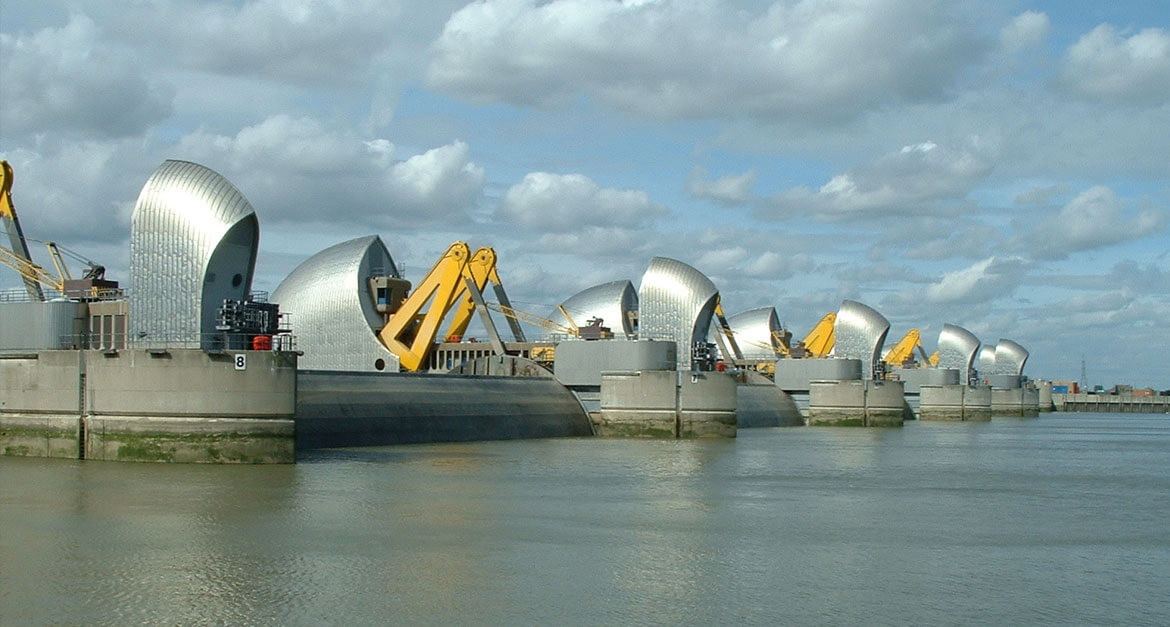
January 2014
Thames Barrier – 30th Anniversary
The 8th May 2014 marked the 30th anniversary of the official opening of the Thames Barrier by Her Majesty Queen Elizabeth II.
Dick Tappin, Consultant for Rendel, who joined the firm in October 1967, was a member of the original design team for the Thames Barrier.
Dick wrote the following article which was published in New Civil Engineer on 27th March 2014.
“Don’t panic: The Thames Barrier is good until 2070 and beyond” Dick Tappin
I am confident that, provided the Thames Barrier is properly maintained, it will continue to protect London from tidal surges until the year 2070 and beyond.
You may say that as a member of the original design team, “He would say that wouldn’t he”.
The arguments presented in favour of a Thames Barrier 2 (TB2) are:
- the original barrier was designed to protect London to 2030 and, since a replacement could take 15 years, TB2 should be initiated now
- climate change was not discussed in the 1960s, thus the barrier will be subject to higher surges than those for which it was designed;
- the barrier has now reached its limit, having been raised 50 times in the 2013/2014 flood season.
Design levels for the barrier for a 1,000 year return surge for 2030, were derived in the late 1960s on the basis of the limited information then available. It was therefore necessary to be appropriately conservative.
The design level used related to increasing sea surges, to sea level rises, coincident fluvial conditions, the tectonic movement of the south east of England, and the sinking of London on its bed of clay. The levels so derived and used in the design may now be compared with those using today’s state of the art modelling techniques and the considerably better data available.
These show that the flood levels we used in the 1970s were overestimated by 500mm – equivalent to about 40 years of sea level rise under current predictions. Thus the design tidal surge level estimated for 2030 is now that appropriate for 2070. Also relevant, the Rising Sector Gates (RSGs) may be rotated beyond the nominal 90° level to withstand higher surge levels.
Detailed inspections of the steel gates have been made in recently, and the structures and their protective systems have been found to be in excellent condition.
The argument that the barrier has reached its operational limit is apparently supported by the fact that while there were only four flood closures in the 1980s, the Barrier has now been closed to protect London from flooding 174 times, including 50 between December 2013 and March 2014 with 20 on consecutive tides.
The detailed study Thames Estuary 2100 recommended that the barrier should not be used for more than 50 tidal closures annually, to allow adequate time for maintenance. However of the 50 closures this year, 41 of these were for fluvial conditions. The Thames Barrier was designed as a tidal surge barrier, and its use in fluvial flood protection was never considered or anticipated at the time of the design. It has been suggested that this £1.6bn barrier, designed to protect central London should be used more sparingly to protect the few hundred properties close to the river in western London. This was not the reason for Sir Herman Bondi’s recommendation to the government in 1967 that “a major surge tide in London would be a disaster of the singular and immense kind …. It would be a knock-out blow to the nerve centre of the country…”
The Thames Barrier gates were designed at a time of uncertainty, following the Koblenz, Milford Haven and Yarra steel bridge collapses of the early seventies. This required considerable diligence to ensure that they were designed within the required level of confidence. A 1/6th scale steel model of a 61m gate was built at Imperial College and observed under loading to the elastic limit and then to collapse. The design, which required resilience to ship collision, is robust and efficient, developing 90% of the full plastic moment capacity of the gate section at collapse – 25% more than predicted by the codes.
Recent re-analyses of the barrier gates, including sensitivity analyses in relation to corrosion, gate operational angle, and differential head, confirm that they conform to today’s design standards.
The barrier has proved itself time and time again to be very effective, but it should be clear that it is first and foremost a tidal surge defence barrier. The Thames Barrier remains fit for purpose, and provided there is scope for proper maintenance, will continue to remain so to at least 2070.

